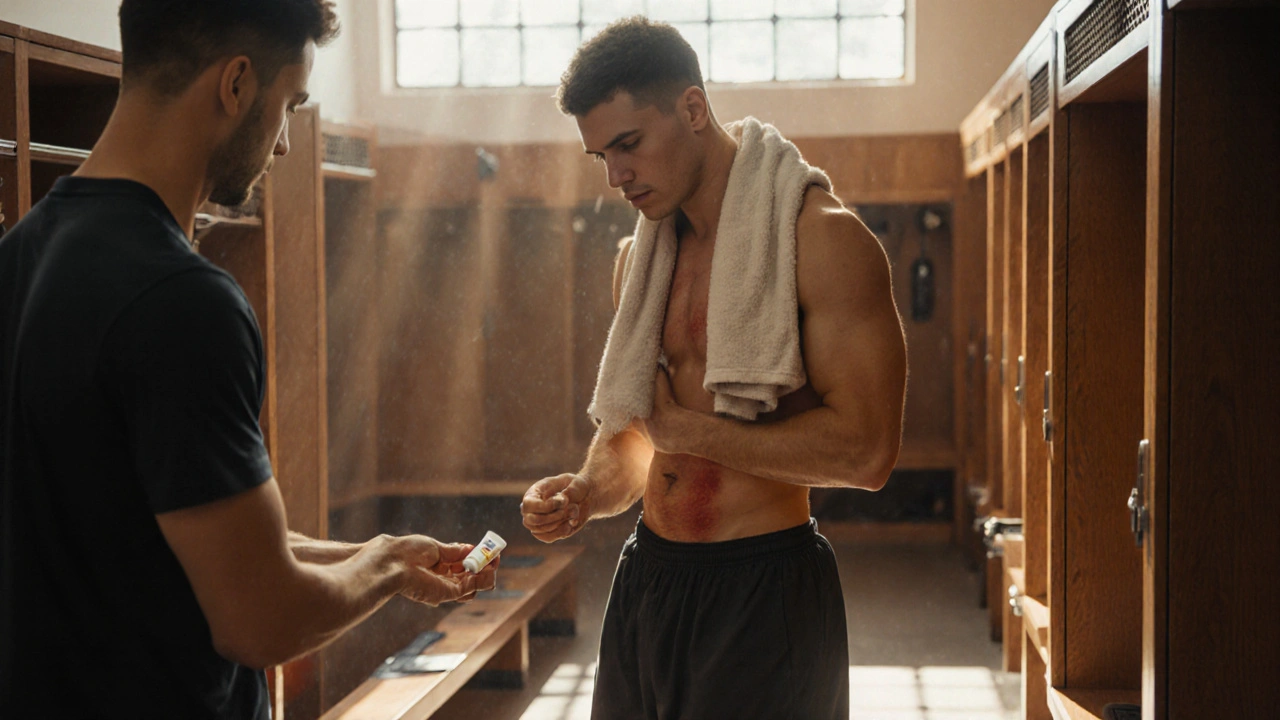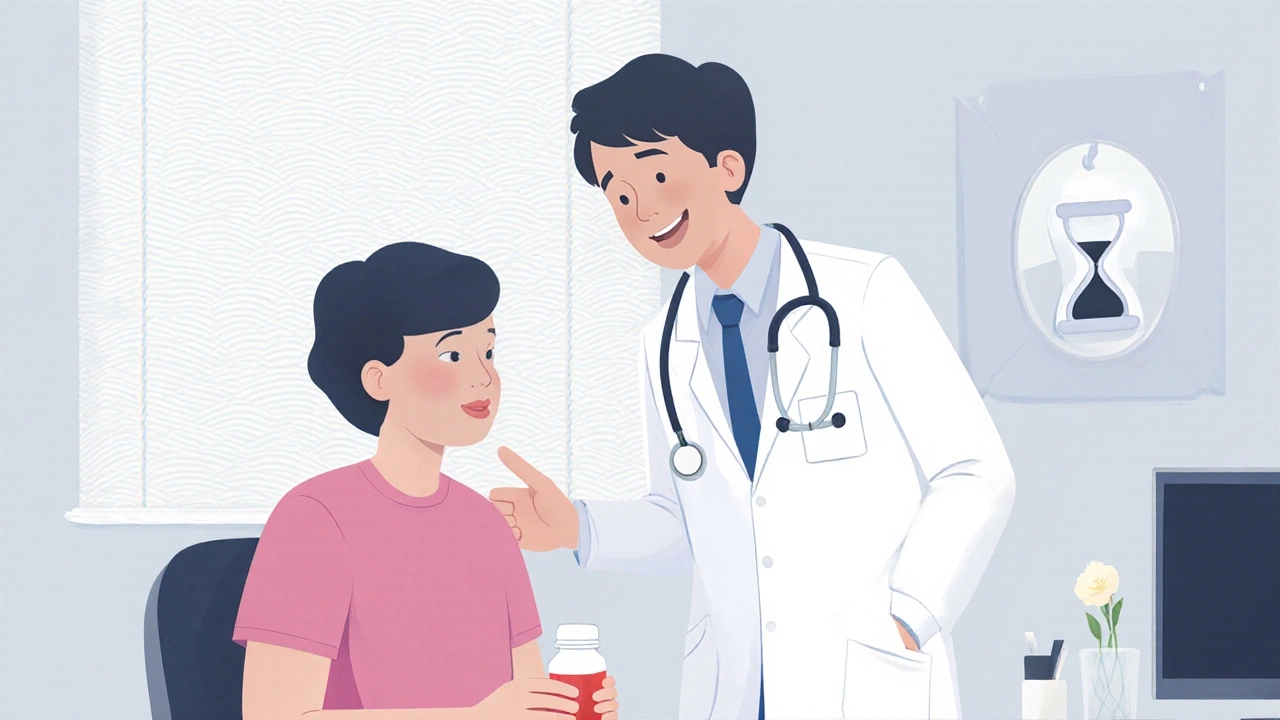29
Jock Itch Duration & Treatment Timeline: What to Expect

Jock Itch Recovery Time Estimator
Enter your symptoms and treatment details to estimate how long your jock itch may take to heal.
Key Points
- Untreated jock itch can linger for weeks to months, but most cases clear in 2-4 weeks with proper care.
- Topical antifungals usually start reducing symptoms within 3-5 days.
- Full skin healing often takes 2-6 weeks, depending on severity and adherence to treatment.
- Oral medication may be needed for extensive or recurrent cases, extending the timeline to 4-8 weeks.
- Seek medical advice if symptoms worsen after one week of over‑the‑counter therapy.
Jock itch is a fungal skin infection, medically called tinea cruris, that thrives in warm, moist areas of the groin, inner thighs, and buttocks. It’s caused by dermatophyte fungi that feed on keratin, the protein in skin cells. Around 15% of adults will experience it at some point, especially those who sweat a lot, wear tight clothing, or have a history of athlete’s foot.
What Triggers a Jock Itch Outbreak?
Understanding the root causes helps you predict how long an episode might last. The main culprits are:
- Moisture: Excess sweat or damp clothing creates a perfect breeding ground for the fungus.
- Friction from tight underwear or sports gear.
- Previous fungal infections like athlete’s foot, which can spread to the groin.
- Weakened immune system or diabetes, which make the skin more vulnerable.
When any of these factors persist, the infection can linger, pushing the jock itch duration beyond the typical 2-4 weeks.
Typical Duration Without Treatment
If you ignore the rash, you’ll likely see a slow‑burn pattern: the red, scaly patch expands gradually, itching intensifies, and sometimes a foul odor develops. In mild cases, the body’s immune response may eventually curb the fungus after 4-6 weeks, but the skin often remains discolored and itchy for weeks longer. Severe or recurrent cases can drag on for months, especially if the environment stays humid.
Treatment Options Overview
Most people clear jock itch with over‑the‑counter (OTC) preparations, but the choice depends on how deep the infection goes.
| Treatment | Typical Duration | Prescription Needed? | Common Side Effects |
|---|---|---|---|
| Topical azole creams (clotrimazole, miconazole) | 2-4 weeks | No | Skin irritation, burning |
| Topical allylamine creams (terbinafine) | 1-3 weeks | No | Mild itching, redness |
| Oral antifungal tablets (fluconazole, itraconazole) | 4-8 weeks | Yes | Nausea, liver enzymes elevation |
| Home remedies (tea tree oil, apple cider vinegar) | Variable, often >4 weeks | No | Skin sensitivity |
For most first‑time infections, a topical azole or allylamine cream applied twice daily is enough. Oral meds are reserved for widespread, stubborn, or recurrent cases.
Step‑by‑Step Timeline of Healing
- Day 0‑2: Start Treatment - Apply the chosen cream to clean, dry skin. You’ll notice itching may intensify as the fungus starts dying; this is normal.
- Day 3‑5: Early Relief - Most users report a noticeable drop in itch and redness. If there’s no change, double‑check you’re applying the medication to the entire affected area, not just the most visible spot.
- Day 6‑10: Visible Fade - The outer scaly layer begins to peel. Continue using the cream for the full course, even if the rash looks gone.
- Day 11‑21: Deep Healing - Skin underneath regenerates. This phase is crucial; missing doses or resuming sweaty workouts too soon can reignite the fungus.
- Week 4‑6: Final Clearance - All redness and discoloration fade. For extensive infections, a second 2‑week course may be prescribed.
- Beyond Week 6: Prevention Mode - Maintain dry skin, breathable underwear, and occasional antifungal powder to avoid a comeback.
Oral therapy adds an extra 2‑4 weeks to the timeline because the medication works systemically, reaching deeper skin layers.

Managing Symptoms While You Heal
Even with the right medication, you’ll likely deal with itching, burning, or a mild rash during the first week. Here’s how to keep discomfort low:
- Moisture control: Pat the area dry after showering; use a powder that contains zinc oxide to absorb excess sweat.
- Wear loose, cotton underwear that lets air circulate.
- Avoid hot tubs, saunas, and prolonged cycling until the rash clears.
- Apply a cool compress for 10 minutes a few times a day if burning is severe.
- Do not scratch. Scratching can break the skin, creating a portal for bacterial infection.
Tips to Speed Up Recovery
Speed isn’t just about medication; lifestyle tweaks make a big difference.
- Hygiene routine: Shower immediately after exercising; change into dry clothes within an hour.
- Foot care: Treat athlete’s foot simultaneously; the fungi often travel from feet to groin.
- Weight management: Excess weight can increase skin folds and moisture, so a balanced diet helps.
- Stay hydrated: Well‑hydrated skin repairs faster.
- Regular laundry: Wash underwear in hot water (at least 60°C) and dry on high heat.
When to Seek Professional Help
Most cases resolve with OTC creams, but you should see a doctor if:
- No improvement after 7-10 days of diligent topical treatment.
- The rash spreads to the abdomen, buttocks, or beyond the groin.
- You develop blisters, pus, or a foul smell.
- You have a weakened immune system, diabetes, or are on immunosuppressive medication.
- Recurring infections happen more than two times a year.
A clinician can prescribe oral antifungals, perform a skin scrape to confirm the fungus, or rule out other conditions like inverse psoriasis or bacterial cellulitis.
Common Pitfalls and How to Avoid Them
- Stopping early: Cutting treatment short because the rash looks better leads to relapse.
- Using oily creams: Heavy ointments trap moisture, feeding the fungus.
- Neglecting the surrounding skin: Applying cream only to the most obvious patch leaves hidden spores alive.
- Sharing towels or clothing: Fungal spores can spread to partners or family members.
Bottom Line
With the right approach, most people see relief within the first week and full clearance in under a month. Staying dry, adhering to the full medication course, and addressing any foot fungus are the pillars of a swift recovery. If symptoms linger beyond the expected timeline, a healthcare professional can guide you to stronger options and rule out complications.
Frequently Asked Questions
How long does jock itch usually last without treatment?
Without any antifungal care, a mild case can persist for 4-6 weeks, while more extensive infections may linger for several months, especially if moisture and friction continue.
When will I see the first relief after applying a cream?
Most topical azoles or allylamines start reducing itching and redness within 3-5 days of twice‑daily application.
Do I need a prescription for jock itch?
Over‑the‑counter creams are enough for first‑time, localized cases. Prescription oral antifungals are reserved for widespread, stubborn, or recurring infections.
Can I still exercise while treating jock itch?
Light activity is fine, but avoid heavy sweating, tight gear, and prolonged friction until the rash clears. Change out of damp clothes immediately after exercising.
What should I do if the rash spreads?
A spreading rash signals that the infection is not responding. Book an appointment; a doctor may take a skin sample, prescribe oral medication, and check for secondary bacterial infection.









Mary Magdalen
September 29, 2025 AT 01:37Look, jock itch isn’t some exotic plague, it’s a common fungal irritation that anyone who sweats enough can get. The timeline you posted is spot on for most cases, but the real kicker is adherence – skip a day and you’ll see the itch flare up like a bad roommate. Also, don’t underestimate the power of breathable underwear; cotton does wonders where synthetic gear fuels the fungus. If you’re in a humid climate, consider powder with zinc oxide to keep the area dry. Bottom line: follow the regimen and you’ll be itch‑free in about a month.
Dhakad rahul
October 3, 2025 AT 01:38🔥 Wow, this guide reads like a saga of battle against the fungal nemesis! From day zero to week six, you’ve mapped the epic journey with the precision of a warrior poet. I’m especially impressed by the “Stay hydrated” tip –‑ mind‑blowing, right? 😂 Keep those creams coming and the fungus will surrender in no time.
William Dizon
October 7, 2025 AT 01:39For anyone staring at this page wondering where to start, here’s a quick cheat‑sheet: 1) Clean the area with mild soap and dry thoroughly. 2) Apply a topical azole twice daily for at least two weeks, even if the rash looks better after a few days. 3) If you notice no improvement after 7‑10 days, consider stepping up to an oral antifungal, especially for extensive cases. 4) Keep the groin area ventilated – loose cotton underwear is a game‑changer. 5) Remember to treat any athlete’s foot at the same time to prevent reinfection.
Jenae Bauer
October 11, 2025 AT 01:40When you think about the life cycle of a fungus, it’s almost poetic – a spore lands, germinates, spreads, and then, if unchecked, festers like a tiny rebel nation on your skin. The worst part is that most people ignore the early warning signs, assuming it’s just a rash, and let it grow into a full‑blown outbreak that can dominate the groin region for weeks. First, the moist environment of the inner thigh offers the perfect breeding ground, especially after a sweaty workout or a long bike ride, and the friction from tight clothing further stresses the skin, making it more vulnerable. Once the dermatophyte establishes itself, the immune system launches a localized response, which shows up as itching, redness, and that characteristic scaly border. Your body tries to expel the fungus, but the skin’s barrier can be compromised, allowing the infection to spread laterally. That’s why the initial 3‑5 days of topical treatment can feel like an onslaught – the dying fungi release inflammatory compounds that intensify the itch before relief sets in. If you adhere strictly to the prescribed regimen, the antifungal agents penetrate the stratum corneum and eradicate the spores, usually within two to four weeks for mild to moderate cases. However, if you skip doses or re‑expose the area to moisture, you give the fungus a second wind, and the timeline stretches dramatically. Oral antifungals, while more systemic, take longer to clear because they need to reach deeper skin layers and the bloodstream before they can starve the organism. Side effects like nausea or liver enzyme changes are why doctors reserve them for severe or recurrent infections. Moreover, the psychosocial impact of a persistent jock itch can’t be ignored – anxiety about appearance, discomfort during intimacy, and the constant urge to scratch can affect mental health. Lifestyle tweaks such as changing into dry clothes within an hour of sweating, using antifungal powders, and washing underwear in hot water are not just recommendations; they are essential components of a comprehensive treatment plan. In practice, patients who combine medication with rigorous hygiene often see a full resolution in under six weeks, whereas those who rely solely on creams without addressing the environment may see the infection linger for months. So, the timeline isn’t just a fixed number of weeks; it’s a dynamic process shaped by treatment adherence, environmental control, and individual health factors.
vijay sainath
October 15, 2025 AT 01:41The snippet about “stop early” is a classic trap – the fungus loves a half‑finished fight. Keep the cream on for the full course, even if the rash looks gone.
Daisy canales
October 19, 2025 AT 01:42Sure, because everyone loves a good reminder about dry underwear.
keyul prajapati
October 23, 2025 AT 01:43Building on that, it’s worth noting that the micro‑environment of the groin is influenced by more than just sweat; temperature fluctuations, hormonal changes, and even diet can affect skin hydration levels. For instance, a high‑salt diet can increase perspiration, while excessive carbohydrate intake may alter the skin’s pH, creating a more hospitable arena for fungal growth. Therefore, a holistic approach that includes dietary moderation, adequate hydration, and consistent use of antifungal powder can synergize with topical treatments to expedite healing. Furthermore, patients should monitor for secondary bacterial infection, which may present as increased redness, swelling, or purulent discharge, and seek medical attention promptly if such signs emerge. In summary, while the primary battle is against the fungus, supporting the skin’s overall health can turn the tide more swiftly.
Alice L
October 27, 2025 AT 00:44Esteemed readers, the foregoing exposition delineates a comprehensive protocol for the management of tinea cruris. It is recommended that one adheres scrupulously to the prescribed therapeutic regimen whilst maintaining optimal personal hygiene. Kindly consider the aforementioned guidelines to ameliorate the condition expeditiously.
Seth Angel Chi
October 31, 2025 AT 00:45Honestly the advice is basic and over‑explained.
Kristen Ariies
November 4, 2025 AT 00:46Alright folks, strap in! This is the moment where you take control of that relentless itch, and trust me, the relief is just around the corner!!! Apply that cream, keep it dry, and watch the fungus crumble like a sandcastle in a storm!!! You’ve got this!!!
Ira Bliss
November 8, 2025 AT 00:47You're absolutely right – staying dry and using powder is a game‑changer! 🌟 Keep the area ventilated, change out of sweaty clothes ASAP, and the healing process will speed up dramatically. 🙌 Stay motivated, you’ll be itch‑free before you know it! 😊
Donny Bryant
November 12, 2025 AT 00:48Good point! Also make sure to wash your underwear in hot water. That kills any leftover spores.
kuldeep jangra
November 16, 2025 AT 00:49From my experience as a coach, I’ve seen many athletes battle jock itch, and the key takeaway is consistency. It’s not enough to slap on a cream once and hope for the best; you have to apply it diligently, twice a day, for the entire recommended period. Pair that with a routine of showering immediately after any physical activity, changing into dry, breathable clothing, and perhaps even using an antifungal powder as a preventative measure. I’ve guided numerous teammates who, after adopting this disciplined approach, reported a noticeable reduction in itching within just a few days and complete clearance within a month. Remember, the body’s natural healing processes work best when you remove the conditions that allow the fungus to thrive – moisture, heat, and friction.
harry wheeler
November 20, 2025 AT 00:50Indeed the routine I described aligns with standard dermatological advice.
faith long
November 24, 2025 AT 00:51Look, I’ve been dealing with this crap for longer than most of you have been alive, and let me tell you straight – half‑assing the treatment is a recipe for disaster. The fungus is relentless, and if you think you can outsmart it by skipping doses, you’re just inviting a relapse that will make the itching worse than ever. You need to be ruthless with your schedule: apply the medication on schedule, dry the area like you would after a marathon, and never, ever wear tight synthetic gear until it’s fully cleared. And if you even consider ignoring the foot fungus, you’ll be watching that same fungus migrate back into the groin, setting you back weeks. So get your act together, follow the plan to the letter, and you’ll be back to a normal life without that burning fire below your belt.
Danny Wakefield
November 28, 2025 AT 00:52Some people think jock itch is just a simple fungal infection, but there’s a whole hidden industry pushing cheap creams while they profit from chronic cases. That’s why I always suggest pairing OTC meds with a strict hygiene protocol – it cuts off the supply chain they rely on. If you stay vigilant, you won’t become a repeat customer for their products.
Randy Faulk
December 2, 2025 AT 00:52Dear reader, if you find that over‑the‑counter creams are ineffective after a ten‑day trial, it is advisable to seek a professional consultation. A physician can prescribe systemic antifungal therapy, which often resolves extensive infections within four to eight weeks. Additionally, laboratory analysis of skin scrapings can confirm the presence of dermatophytes and rule out other dermatoses.
Brandi Hagen
December 6, 2025 AT 00:37😂 Oh please, the timeline is practically a myth – everyone’s body reacts differently, but if you stick to the regimen and keep things dry, you’ll be fine. Trust the science, not the hype! 🚀